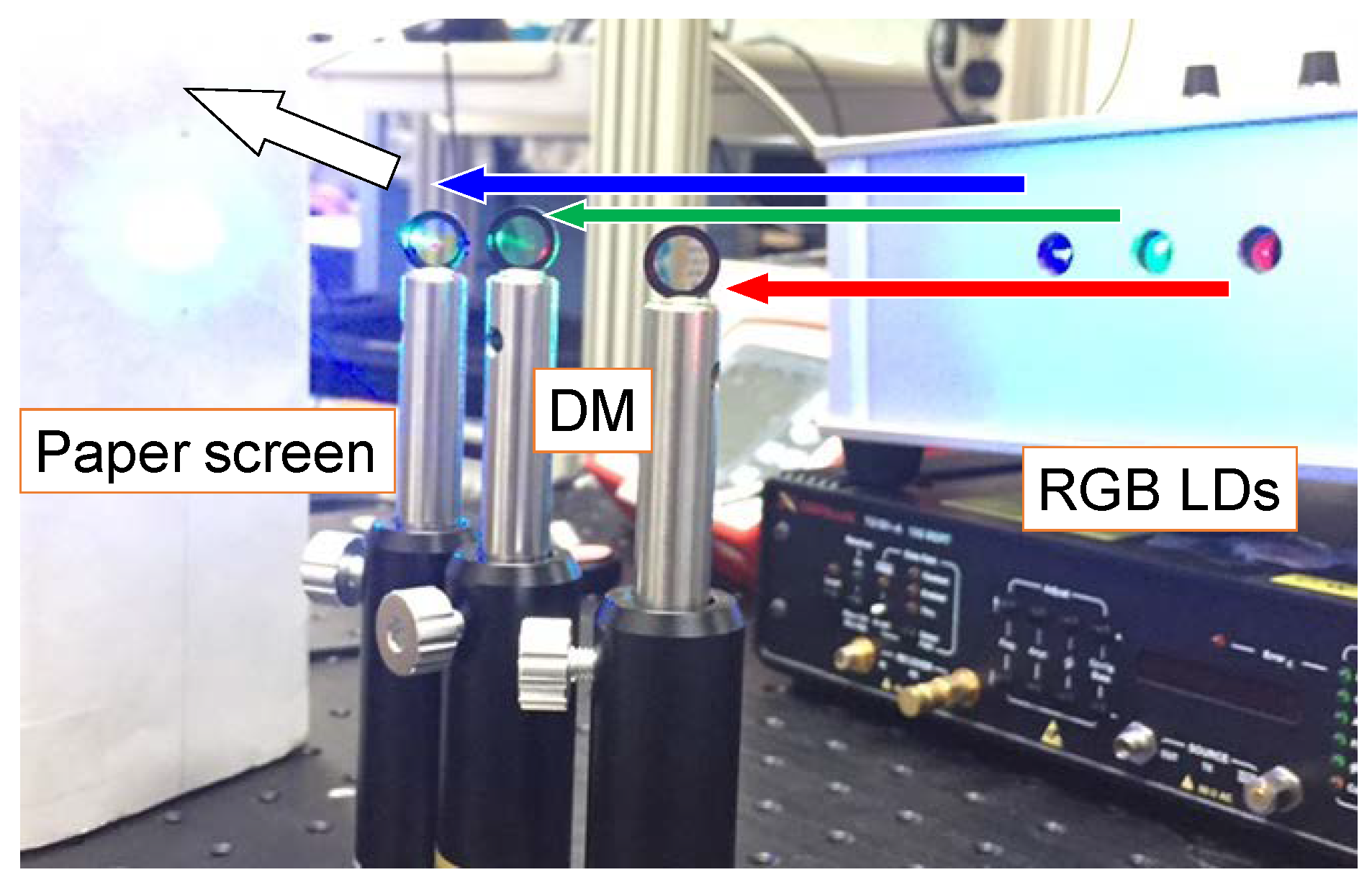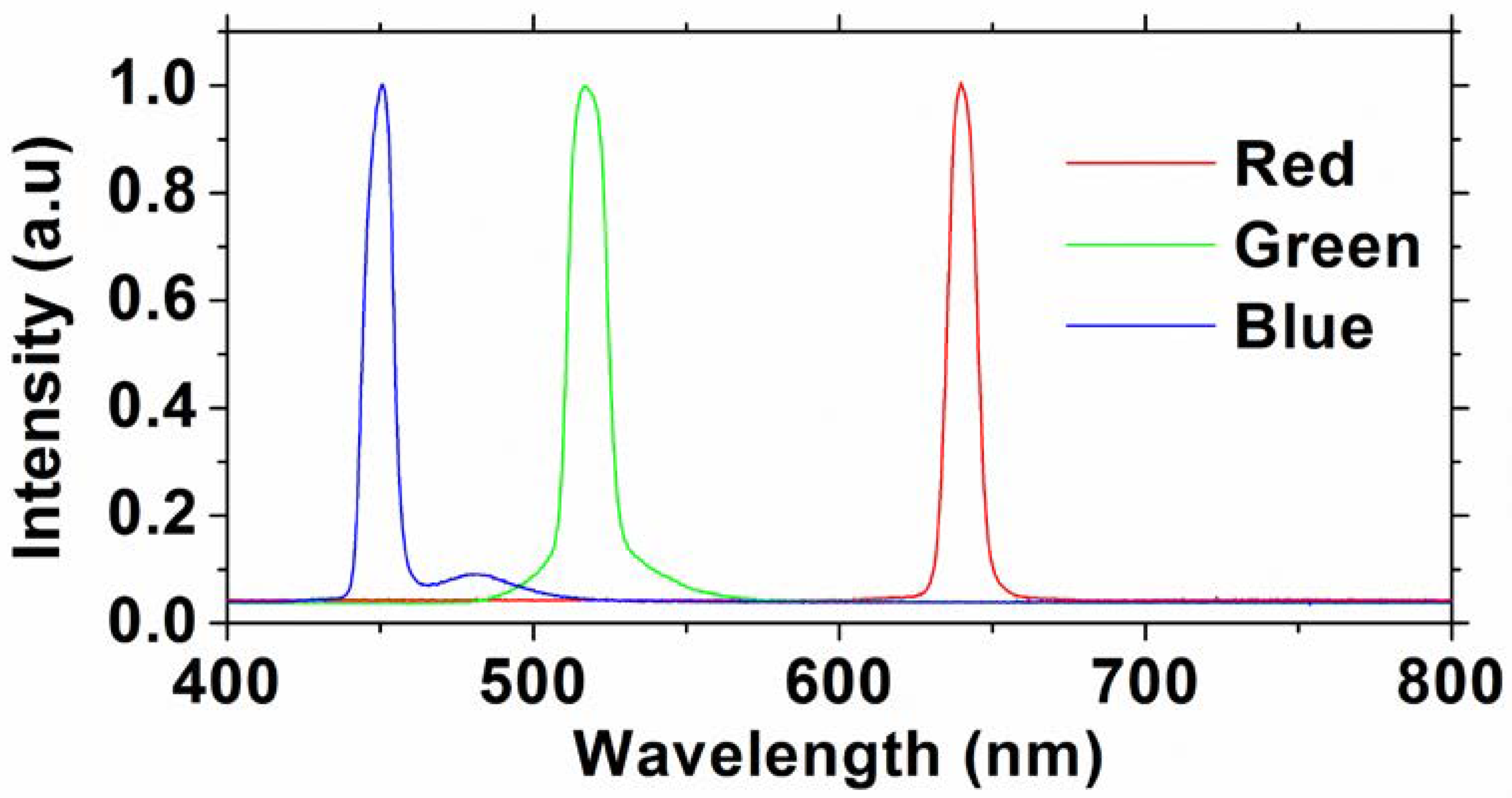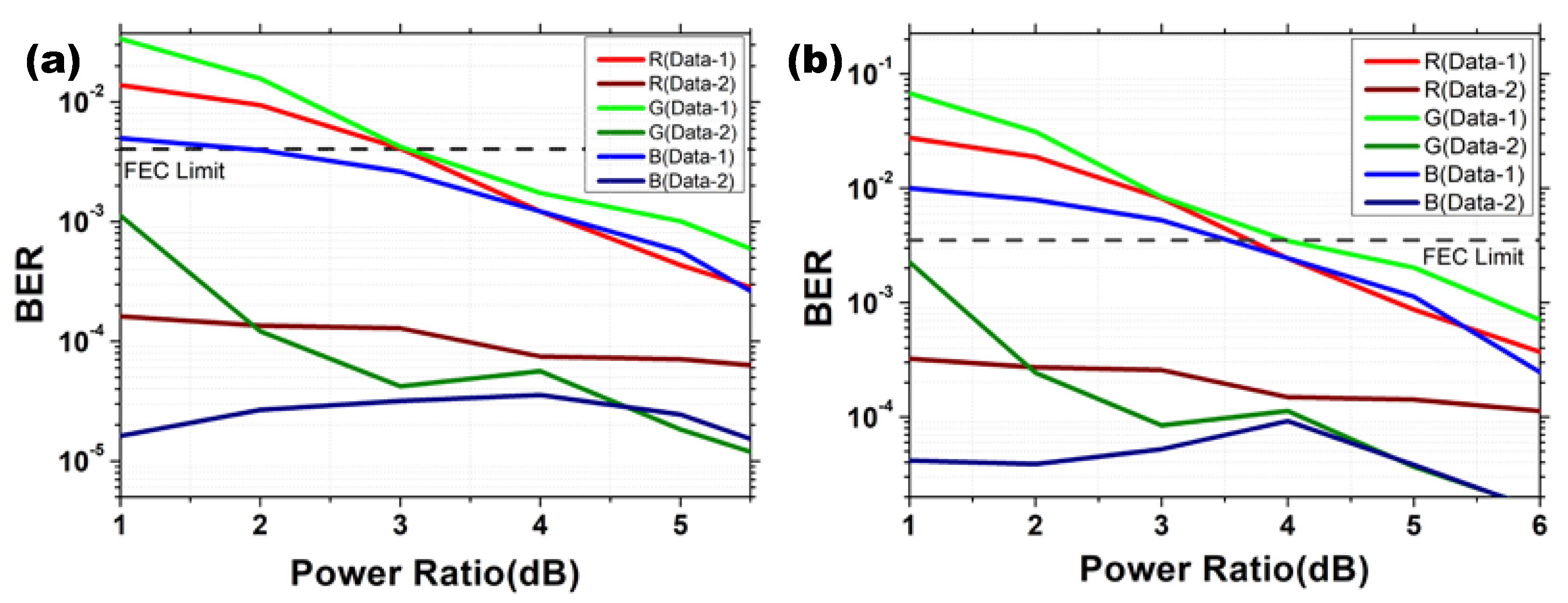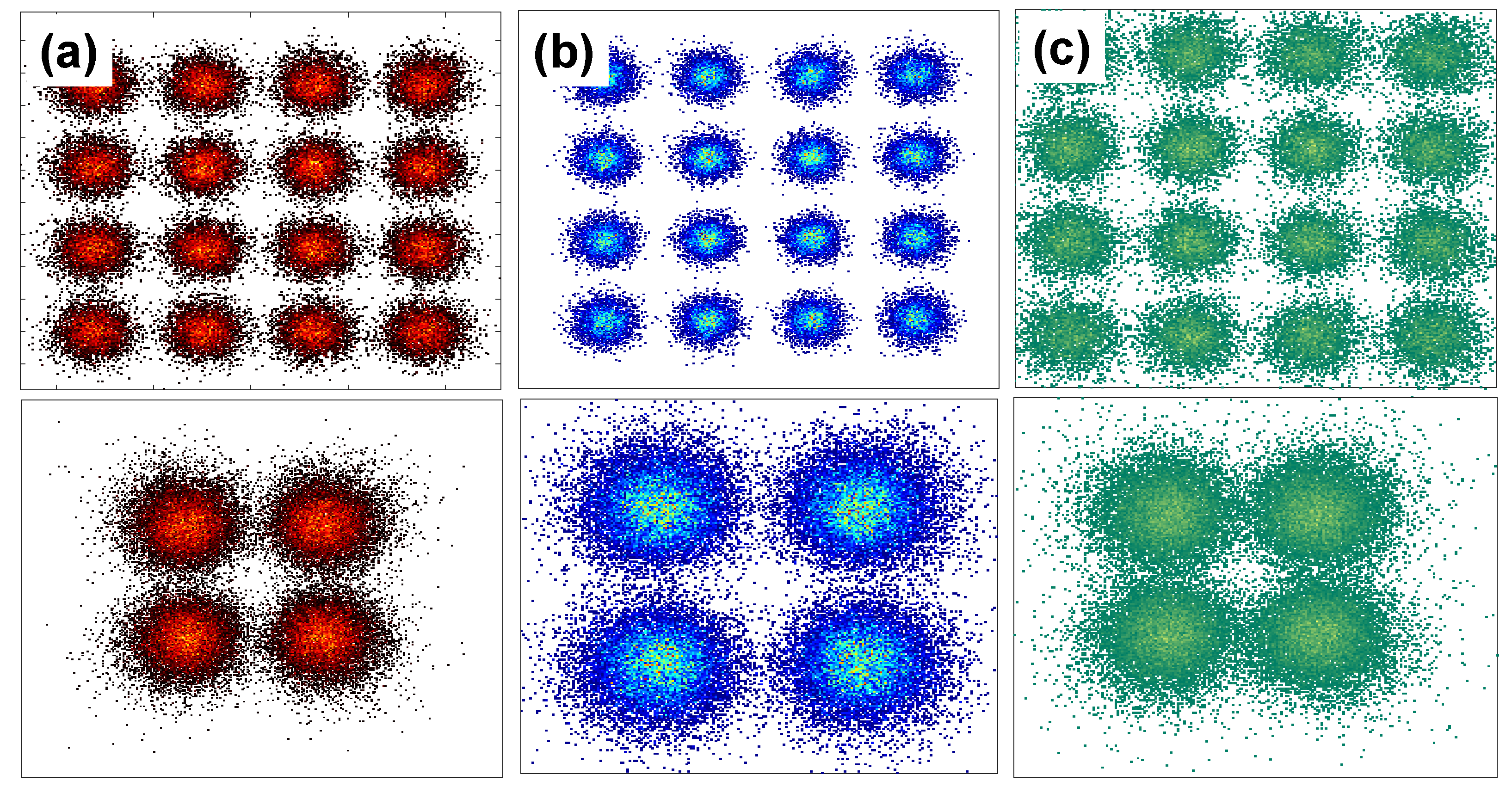Optical Beam Steerable Visible Light Communication (VLC) System Supporting Multiple Users Using RGB and Orthogonal Frequency Division Multiplexed (OFDM) Non-Orthogonal Multiple Access (NOMA)
Abstract
:1. Introduction
2. Algorithm and Experiment
3. Results and Discussion
4. Conclusions
Author Contributions
Funding
Institutional Review Board Statement
Informed Consent Statement
Data Availability Statement
Conflicts of Interest
References
- Chow, C.W.; Yeh, C.H.; Liu, Y.; Lai, Y.; Wei, L.Y.; Hsu, C.W.; Chen, G.H.; Liao, X.L.; Lin, K.H. Enabling Techniques for Optical Wireless Communication Systems. Proc. OFC 2020, M2F.1. (Invited). Available online: https://ieeexplore.ieee.org/document/9083268 (accessed on 24 October 2022).
- Chi, N.; Zhou, Y.; Wei, Y.; Hu, F. Visible light communication in 6G: Advances, challenges, and prospects. IEEE Veh. Technol. Mag. 2020, 15, 93–102. [Google Scholar] [CrossRef]
- Li, C.Y.; Lu, H.H.; Tsai, W.S.; Feng, C.Y.; Chou, C.R.; Chen, Y.H.; Nainggolan, A. White-lighting and WDM-VLC system using transmission gratings and an engineered diffuser. Opt. Lett. 2020, 45, 6206–6209. [Google Scholar] [CrossRef]
- Wei, L.Y.; Liu, Y.; Chow, C.W.; Chen, G.H.; Peng, C.W.; Guo, P.C.; Tsai, J.F.; Yeh, C.H. 6.915-Gbit/s white-light phosphor laser diode-based DCO-OFDM visible light communication (VLC) system with functional transmission distance. Electron. Lett. 2020, 56, 945–947. [Google Scholar] [CrossRef]
- Lu, H.H.; Lin, Y.P.; Wu, P.Y.; Chen, C.Y.; Chen, M.C.; Jhang, T.W. A multiple-input-multiple-output visible light communication system based on VCSELs and spatial light modulators. Opt. Exp. 2014, 22, 3468–3474. [Google Scholar] [CrossRef]
- Chang, C.H.; Li, C.Y.; Lu, H.H.; Lin, C.Y.; Chen, J.H.; Wan, Z.W.; Cheng, C.J. A 100-Gb/s multiple-input multiple-output visible laser light communication system. J. Lightw. Technol. 2014, 32, 4723–4729. [Google Scholar] [CrossRef]
- Shen, C.; Guo, Y.; Oubei, H.M.; Ng, T.K.; Liu, G.; Park, K.H.; Ho, K.T.; Alouini, M.-S.; Ooi, B.S. 20-meter underwater wireless optical communication link with 1.5 Gbps data rate. Opt. Exp. 2016, 24, 25502–25509. [Google Scholar] [CrossRef]
- Lu, H.H.; Li, C.Y.; Lin, H.H.; Tsai, W.S.; Chu, C.A.; Chen, B.R.; Wu, C.J. An 8 m/9.6 Gbps underwater wireless optical communication system. IEEE Photon. J. 2016, 8, 7906107. [Google Scholar]
- Huang, X.H.; Lu, H.H.; Chang, P.S.; Liu, C.X.; Lin, Y.Y.; Ko, T.; Chen, Y.T. Bidirectional white-lighting WDM VLC–UWOC converged systems. J. Lightw. Technol. 2021, 39, 4351–4359. [Google Scholar] [CrossRef]
- Danakis, C.; Afgani, M.; Povey, G.; Underwood, I.; Haas, H. Using a CMOS camera sensor for visible light communication. In Proceedings of the IEEE Globecom Workshops 2012, Anaheim, CA, USA, 3–7 December 2012; pp. 1244–1248. [Google Scholar]
- Chow, C.W.; Liu, Y.; Yeh, C.H.; Chang, Y.H.; Lin, Y.S.; Hsu, K.L.; Liao, X.L.; Lin, K.H. Display light panel and rolling shutter image sensor based optical camera communication (OCC) using frame-averaging background removal and neural network. J. Lightw. Technol. 2021, 39, 4360–4366. [Google Scholar] [CrossRef]
- Chuang, Y.C.; Li, Z.Q.; Hsu, C.W.; Liu, Y.; Chow, C.W. Visible light communication and positioning using positioning cells and machine learning algorithms. Opt. Exp. 2019, 27, 16377–16383. [Google Scholar] [CrossRef] [PubMed]
- Hsu, C.W.; Su, S.J.; Chen, Y.W.; Zhou, Q.; Alfadhli, Y.; Chang, G.K. Real-time demonstration of 5G MMW beamforming and tracking using integrated visible light positioning system. Proc. OFC 2021, paper Tu5E.6. Available online: https://ieeexplore.ieee.org/document/9489670 (accessed on 24 October 2022).
- Minh, H.L.; O’Brien, D.; Faulkner, G.; Zeng, L.; Lee, K.; Jung, D.; Oh, Y.J.; Won, E.T. 100-Mb/s NRZ visible light communications using a post-equalized white LED. IEEE Photon. Technol. Lett. 2009, 21, 1063–1065. [Google Scholar] [CrossRef]
- Hsu, C.H.; Chow, C.W.; Lu, I.C.; Liu, Y.L.; Yeh, C.H.; Liu, Y. High speed imaging 3 × 3 MIMO phosphor white-light LED based visible light communication system. IEEE Photon. J. 2016, 8, 7907406. [Google Scholar] [CrossRef]
- Armstrong, J. OFDM for optical communications. J. Lightw. Technol. 2009, 27, 189–204. [Google Scholar] [CrossRef]
- Dissanayake, S.D.; Armstrong, J. Comparison of ACO-OFDM, DCO-OFDM and ADO-OFDM in IM/DD systems. J. Lightw. Technol. 2013, 31, 1063–1072. [Google Scholar] [CrossRef]
- Cossu, G.; Khalid, A.M.; Choudhury, P.; Corsini, R.; Ciaramella, E. 3.4 Gbit/s visible optical wireless transmission based on RGB LED. Opt. Exp. 2012, 20, B501–B506. [Google Scholar] [CrossRef]
- Lu, I.C.; Lai, C.H.; Yeh, C.H.; Chen, J. 6.36 Gbit/s RGB LED-Based WDM MIMO Visible Light Communication System Employing OFDM Modulation. Proc. OFC 2017, Paper W2A39. Available online: https://ieeexplore.ieee.org/document/7937382 (accessed on 24 October 2022).
- Chi, N.; Zhang, M.; Zhou, Y.; Zhao, J. 3.375-Gb/s RGB-LED based WDM visible light communication system employing PAM-8 modulation with phase shifted Manchester coding. Opt. Exp. 2016, 24, 21663–21673. [Google Scholar] [CrossRef]
- Zhu, X.; Wang, F.; Shi, M.; Chi, N.; Liu, J.; Jiang, F. 10.72Gb/s Visible Light Communication System Based on Single Packaged RGBYC LED Utilizing QAM-DMT Modulation with Hardware Pre-Equalization. Proc. OFC 2018, paper M3K.3. Available online: https://ieeexplore.ieee.org/document/8385820 (accessed on 24 October 2022).
- Watson, S.; Tan, M.; Najda, S.P.; Perlin, P.; Leszczynski, M.; Targowski, G.; Grzanka, S.; Kelly, A.E. Visible light communications using a directly modulated 422 nm GaN laser diode. Opt. Lett. 2013, 38, 3792–3794. [Google Scholar] [CrossRef] [PubMed]
- Chi, Y.C.; Hsieh, D.H.; Tsai, C.T.; Chen, H.Y.; Kuo, H.C.; Lin, G.R. 450-nm GaN laser diode enables high-speed visible light communication with 9-Gbps QAM-OFDM. Opt. Exp. 2015, 23, 13051–13059. [Google Scholar] [CrossRef] [PubMed] [Green Version]
- Wu, T.C.; Chi, Y.C.; Wang, H.Y.; Tsai, C.T.; Huang, Y.F.; Lin, G.R. Tricolor R/G/B laser diode based eye-safe white lighting communication beyond 8 Gbit/s. Sci. Rep. 2017, 7, 11. [Google Scholar] [CrossRef] [PubMed] [Green Version]
- Lu, I.C.; Yeh, C.H.; Hsu, D.Z.; Chow, C.W. Utilization of 1-GHz VCSEL for 11.1-Gbps OFDM VLC wireless communication. IEEE Photon. J. 2016, 8, 7904106. [Google Scholar] [CrossRef]
- Wei, L.Y.; Hsu, C.W.; Chow, C.W.; Yeh, C.H. 20.231 Gbit/s tricolor red/green/blue laser diode based bidirectional signal remodulation visible-light communication system. Photon. Res. 2018, 6, 422–426. [Google Scholar] [CrossRef]
- Gunawan, W.H.; Liu, Y.; Chow, C.W.; Chang, Y.H.; Peng, C.W.; Yeh, C.H. Two-level laser diode color-shift-keying orthogonal-frequency-division-multiplexing (LD-CSK-OFDM) for optical wireless communications (OWC). J. Lightw. Technol. 2021, 39, 3088–3094. [Google Scholar] [CrossRef]
- Chun, H.; Gomez, A.; Quintana, C.; Zhang, W.; Faulkner, G.; O’Brien, D. A wide-area coverage 35 Gb/s visible light communications link for indoor wireless applications. Sci. Rep. 2019, 9, 4952. [Google Scholar] [CrossRef] [Green Version]
- Lin, B.; Ye, W.; Tang, X.; Ghassemlooy, Z. Experimental demonstration of bidirectional NOMA-OFDMA visible light communications. Opt. Express 2017, 25, 4348–4355. [Google Scholar] [CrossRef]
- Shi, J.; He, J.; Hong, Y.; He, J.; Chen, L.K. Performance-enhanced NOMA-VLC using subcarrier pairwise coding. Opt. Commun. 2019, 450, 141–146. [Google Scholar] [CrossRef]
- Adnan, A.; Liu, Y.; Chow, C.W.; Yeh, C.H. Demonstration of non-Hermitian symmetry (NHS) IFFT/FFT size efficient OFDM non-orthogonal multiple access (NOMA) for visible light communication. IEEE Photon. J. 2020, 12, 7201405. [Google Scholar] [CrossRef]
- Wang, Y.; Chen, D.; Jin, J.; Lu, H.; Wang, J. An experimental study of power division multiplexing in visible light communication. Opt. Commun. 2020, 455, 124296. [Google Scholar] [CrossRef]
- Lee, K.; Park, H.; Barry, J.R. Indoor channel characteristics for visible light communications. IEEE Comm. Lett. 2011, 15, 217–219. [Google Scholar] [CrossRef]
- Lee, K.; Park, H. Channel model and modulation schemes for visible light communications. In Proceedings of the 2011 IEEE 54th International Midwest Symposium on Circuits and Systems (MWSCAS), Seoul, Korea, 7–10 August 2011; pp. 1–4. [Google Scholar]
- Saito, Y.; Kishiyama, Y.; Benjebbour, A.; Nakamura, T.; Li, A.; Higuchi, K. Non-orthogonal multiple access (NOMA) for cellular future radio access. In Proceedings of the 2013 IEEE 77th Vehicular Technology Conference (VTC Spring), Dresden, Germany, 2–5 June 2013; pp. 1–5. [Google Scholar]
- Gunawan, W.H.; Chang, Y.; Chow, C.W.; Liu, Y.; Yeh, C.H. High Speed RGB Visible Light Communication (VLC) Using Digital Power-domain Multiplexing (DPDM) of Orthogonal Frequency Division Multiplexed (OFDM) Signals. Proc. OFC 2022, paper Th2A.24. Available online: https://ieeexplore.ieee.org/document/9748209 (accessed on 24 October 2022).
- Gunawan, W.H.; Liu, Y.; Chow, C.W.; Chang, Y.H.; Yeh, C.H. High speed visible light communication using digital power domain multiplexing of orthogonal frequency division multiplexed (OFDM) signals. Photonics 2021, 8, 500. [Google Scholar] [CrossRef]
- Bruno, T.J.; Svoronos, P.D.N. CRC Handbook of Fundamental Spectroscopic Correlation Charts; CRC Press: Boca Raton, FL, USA, 2005; ISBN 9781420037685. [Google Scholar]
- Singh, R.; Pergoloni, S.; O’Farrell, T.; Scarano, G.; David, J.; Biagi, M. White light constrained multi-primary modulation for visible light communication. In Proceedings of the 2017 IEEE Globecom Workshops (GC Wkshps), Singapore, 4–8 December 2017; pp. 1–6. [Google Scholar]
- Wei, L.Y.; Chow, C.W.; Chen, G.H.; Liu, Y.; Yeh, C.H.; Hsu, C.W. Tricolor visible-light laser diodes based visible light communication operated at 40.665 Gbit/s and 2 m free-space transmission. Opt. Express 2019, 27, 25072–25077. [Google Scholar] [CrossRef]
- Wang, Y.; Tao, L.; Huang, X.; Shi, J.; Chi, N. 8-Gb/s RGBY LED-based WDM VLC system employing high-order CAP modulation and hybrid post equalizer. IEEE Photonics J. 2015, 7, 7904507. [Google Scholar]
- Chow, C.W.; Chang, Y.H.; Wei, L.Y.; Yeh, C.H.; Liu, Y. 26.228-Gbit/s RGBV visible light communication (VLC) with 2-m free space transmission. In Proceedings of the 2020 Opto-Electronics and Communications Conference (OECC), Taipei, Taiwan, 4–8 October 2020. [Google Scholar] [CrossRef]













| FSM Freq. (Hz) | Rx Amp. (mV) | Tracked by Piezo | Time for Tracking and Feedback (s) |
|---|---|---|---|
| 1 | 32 | No | - |
| 2 | 44 | No | - |
| 3 | 207 | Yes | 8 |
| 4 | 180 | Yes | 7.8 |
| 5 | 177 | Yes | 7.9 |
| 6–10 | 180 | No need | No need |
Publisher’s Note: MDPI stays neutral with regard to jurisdictional claims in published maps and institutional affiliations. |
© 2022 by the authors. Licensee MDPI, Basel, Switzerland. This article is an open access article distributed under the terms and conditions of the Creative Commons Attribution (CC BY) license (https://creativecommons.org/licenses/by/4.0/).
Share and Cite
Gunawan, W.H.; Chow, C.-W.; Liu, Y.; Chang, Y.-H.; Yeh, C.-H. Optical Beam Steerable Visible Light Communication (VLC) System Supporting Multiple Users Using RGB and Orthogonal Frequency Division Multiplexed (OFDM) Non-Orthogonal Multiple Access (NOMA). Sensors 2022, 22, 8707. https://doi.org/10.3390/s22228707
Gunawan WH, Chow C-W, Liu Y, Chang Y-H, Yeh C-H. Optical Beam Steerable Visible Light Communication (VLC) System Supporting Multiple Users Using RGB and Orthogonal Frequency Division Multiplexed (OFDM) Non-Orthogonal Multiple Access (NOMA). Sensors. 2022; 22(22):8707. https://doi.org/10.3390/s22228707
Chicago/Turabian StyleGunawan, Wahyu Hendra, Chi-Wai Chow, Yang Liu, Yun-Han Chang, and Chien-Hung Yeh. 2022. "Optical Beam Steerable Visible Light Communication (VLC) System Supporting Multiple Users Using RGB and Orthogonal Frequency Division Multiplexed (OFDM) Non-Orthogonal Multiple Access (NOMA)" Sensors 22, no. 22: 8707. https://doi.org/10.3390/s22228707
APA StyleGunawan, W. H., Chow, C.-W., Liu, Y., Chang, Y.-H., & Yeh, C.-H. (2022). Optical Beam Steerable Visible Light Communication (VLC) System Supporting Multiple Users Using RGB and Orthogonal Frequency Division Multiplexed (OFDM) Non-Orthogonal Multiple Access (NOMA). Sensors, 22(22), 8707. https://doi.org/10.3390/s22228707








